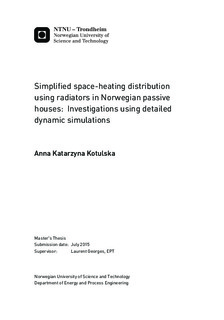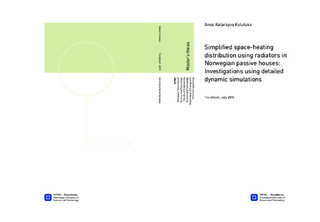| dc.description.abstract | The whole thesis was designed to investigate the relationship between energy efficiency and thermal comfort with regard to the way heat distribution in the passive house as well as control efficiency. In order to verify the assumed also performed simulations in the IDA Indoor Climate and Energy, which is a modern tool for simulation.
When conducting the analysis of the influence, founded the air temperature in the building, the impact of heat distribution method, as well as closing the door openings and pipe insulation, on energy efficiency and thermal comfort in the test building (located in Trondheim, Norway).
Considered temperature situations were divided into:
- Stable temperature equal to 21ºC
- Room temperature variable during the day - during the day and hour 7 am to 11 pm, the temperature is 21 degrees whereas at night - would fall to 19 degrees.
- The last case, the most complicated, similarly as in the previous case that varies in temperature during the day, but in addition, during the year (at Christmas - 25.12 to 31.12), the temperature would drop to 16 degrees because of the absence inhabitants.
Among the above-mentioned objectives in terms of comfort, most preferably dropped situation where temperature change followed only during the day. The most unfavorable in this respect turned out to be an option with the temperature at a constant level.
The most efficient option is to maintain a constant air temperature in the room. This is due to the increased energy demand, which occurs when you need to increase the temperature from 19ºC (night) to 21ºC (day).
Another factor that could have a potential impact on thermal comfort and energy efficiency model was the way the distribution of heat in the building.
Two possibilities were taken into consideration:
- Standard system - where one radiator falls on one room, two-pipe system
- Simplified layout - lines also carried out a two-pipe system, and the heaters are located one on the floor.
With the introduction of this assumption, it turned out that a change in the distribution of heat does not have too much impact on altering perception of comfort but only if we make the assumption unhindered flow of air masses (warm) between the two rooms.
Otherwise (assuming no heat flow) streamlined solution causes a strong feeling of thermal discomfort caused by excessive fluctuations in temperature between the rooms.
This is where there is the need to adopt and verify the assumptions next - door open / closed.
The last inspected the condition insulate distribution lines to the radiator heating medium.
In the absence of pipe insulation heat loss to the environment they were almost twice as high as when the pipes were insulated. This could affect the feeling of comfort in the case of high-temperature heating.
Based on these studies it was concluded that the best solution due to thermal comfort, energy efficiency, and even the economic aspect is to simplify the heating distribution system with mandatory leaving the door open and establish a constant temperature equal to 21ºC in the analyzed object. | |

